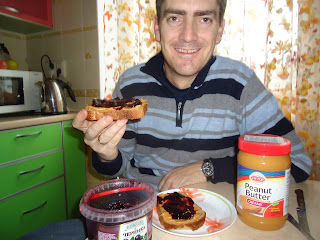This is the story of my HOME TOWN!
We started our travels by leaving Perm by plane and flying to Moscow. In Moscow we got tickets for the "fast" train that took us 4 hours north to Vyshny Volochyok which is very close to the town I was born in.
On the fast train we had a snack, played games, read books and slept.
When we arrived in Vyshny Volochyok I was surprised by the beautiful train station with all the weird stairs that connected the two sides of the track. Next, we walked to the city and the hotel.
As you can see this is not the most interesting room. The hotel room itself is very stuffy. The wall paper was covered with yellow, gunky stuff that showed it hadn't been cleaned since Peter the Great stayed here in 1703. When Mom looked on the internet to find me a really nice hotel room she was excited to find the perfect room at the Birch Hotel. As it turned out we didn't get the one in the picture and ended up with this one that felt like staying inside a tree. But the good news is we left the day after for a much nicer hotel!
This is one of my favorite restaurants where we celebrated our arrival. First of all, I would like to comment that the ladies were very nice. Second of all they have yummy food like blini, pizza, ice cream and hot chocolate. It was so good we came back for breakfast. We didn't know where else to go.
This is an Orthodox church. Inside it's very nice and tidy, except that I feel a little uncomfortable going to that church.
On our second day we took the bus to glass factory in Krasnomaysky, which is the town that I may have lived in. It is a village of 5,000 people. The factory was actually closed, but it was a nice drive.
This is the church across from the factory where we shivered and tried to puff ourselves out to keep us warm.
This is a typical house in the village that has 8 apartments in it.
This is where I might have actually lived because I remember the white and red store. How Exciting!!!!
Back in Vyshny Volochyok we were looking for more sites to see.
Beautiful view isn't it? Vyshny Volochyok is a canal town that connected St. Petersburg to Moscow with the canal system. This was one of the few locations that boats would need to portage.
It's a very cold rainy day.
Here is the theater on the town square.
This is the memorial of artists for the region.
At the museum we saw animals, clothes and the history of Vyshny Volochyok.
It is very comforting to find one of these signs at your hotel room. Needless to say there were not any of these at our first hotel room.
We celebrated by having a nice dinner in a very bright room and by buying me a silver ring to remember my city.
I hope you enjoyed this presentation. Lika










































